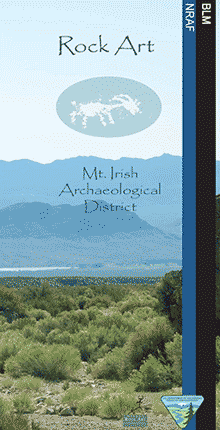Mount Irish Archaeological District
The Mount Irish Archaeological District, located on the eastern flank of the Mount Irish Range, is one of the most important archaeological areas in eastern Nevada. The District covers 640 acres and provides a vista of prehistoric rock art and habitation sites, set in a dramatic landscape of tuff (volcanic ash) knolls and outcrops, alluvial fans, and washes. The District is best known for spectacular rock art that portrays the cultural lives of the Native American peoples who used the area some 4,000 years ago to the nineteenth century. The three largest rock art sites in the District have interpretive trails and a trail guide that is available at visitor register boxes at these sites.
Eastern Nevada, until the coming of Euro-American settlers in the nineteenth century, was settled by hunter-gatherer cultures who skillfully harvested the wild resources of this arid region for several thousand years. Aided by deep knowledge of the environment’s animal and plant resources, hunter-gatherers used efficient technology and lived in small, mobile family groups to gather seasonally available plants, animals, and other resources across the landscape. The Mt. Irish area was used for short-term stays to hunt animals, gather plants, and make rock art. These repeated visits stretch back as far as 4,000 years ago but became more intensive and frequent during the period 2,000-500 years ago.
The Mt. Irish area has two main rock art styles, one (Pahranagat Style) whose cultural affiliation is uncertain and one generally associated with hunter-gatherers (Basin and Range tradition). The Pahranagat Style is an enigmatic portrayal of people that is found mostly at sites in Pahranagat Valley and is unique to Lincoln County. In this style people were portrayed in two very different ways. One form has oval or rectangular solid-pecked bodies, large eyes, a short line protruding from the head, and hands that have long fingers. The other form has a rectangular body that has geometric designs or straight lines inside, stick-figure arms and legs. Sometimes these are portrayed holding objects that resemble atlatls (dart throwers), suggesting this style was made before the bow-and-arrow was widely adopted in the region some 1,500 years ago. The District also is home to one of the largest concentrations of bighorn sheep images in eastern Nevada.
Rock art, settlement, and economic activities are intertwined in the Mt. Irish area. Many rock art sites are accompanied by the remains of campsites and foraging activities. Rock-shelters, middens, stone tools, and fragments of tools show that animals and plants were often processed in the vicinity of rock art. Were people drawn to the area by seasonally by available resources, or did the area have a special social and cultural significance, marked by rock art, that explains why hunter-gatherers visited the area? The exact meanings and cultural significance of Mt. Irish’s rock art and its landscape may be unknowable, but these cultural marks indicate the area was important to the peoples who used these galleries of ancient art. The rock art and the Mt. Irish area continue today to be important to Native American peoples living in the region.
This webpage and the brochure were produced by NRAF with the assistance of a grant from the Lincoln County Archaeological Initiative.
